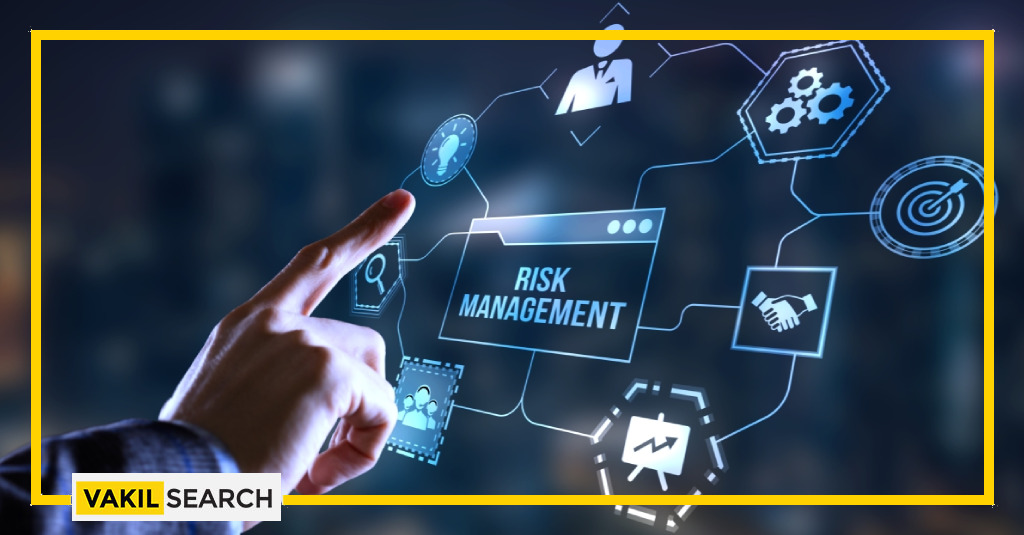In this post, Vakilsearch experts will explain the ins and outs of the 5 steps involved in the professional risk management process.
What are the 5 Risk Management Process?
The Risk management process:
- Establish the context. This includes defining the scope of the risk management project, identifying the stakeholders, and setting the objectives.
- Identify the risks. This involves identifying all of the potential risks that could impact the project, including both internal and external risks.
- Assess the risks. This involves evaluating the likelihood and impact of each risk and then prioritizing the risks based on their level of risk.
- Treat the risks. This involves developing and implementing strategies to mitigate the risks, such as avoiding, transferring, reducing, or accepting the risks.
- Monitor and review the risks. This involves keeping track of the risks and making sure that the risk management plan is still effective.
What are the 5 Components of Risk?
The 5 components of risk are:
- Threat: A potential event or occurrence that can harm an organization.
- Vulnerability: A weakness or flaw in an organization’s systems or processes that can be exploited by a threat.
- Impact: The potential negative consequences of a risk event occurring.
- Likelihood: The probability that a risk event will occur.
- Risk: The combination of the likelihood and impact of a risk event.
What are the 3 Steps in Managing Risks?
The 3 steps in managing risks are:
- Identify the Risks. This involves identifying all of the potential risks that could impact the organization.
- Assess the risks. This involves evaluating the likelihood and impact of each risk and then prioritizing the risks based on their level of risk.
- Treat the risks. This involves developing and implementing strategies to mitigate the risks, such as avoiding, transferring, reducing, or accepting the risks.
What are the 5 Steps Process of Risk Assessment?
The 5 step process of risk assessment is:
- Identify the risks. This involves identifying all of the potential risks that could impact the organization.
- Describe the risks. This involves documenting the details of each risk, such as the likelihood, impact, and potential consequences.
- Assess the risks. This involves evaluating the likelihood and impact of each risk, and then prioritizing the risks based on their level of risk.
- Treat the risks. This involves developing and implementing strategies to mitigate the risks, such as avoiding, transferring, reducing, or accepting the risks.
- Monitor and review the risks. This involves keeping track of the risks and making sure that the risk management plan is still effective.
What are the 5 Steps of Risk Management?
The 5 Rs of risk management are:
- Recognize: The first step in risk management is to recognize that risks exist.
- Review: Once risks have been identified, they need to be reviewed on a regular basis to ensure that they are still relevant.
- Respond: If a risk is identified, it needs to be responded to in a timely and appropriate manner.
- Reduce: The goal of risk management is to reduce the likelihood and impact of risks.
- Reassure: Once risks have been managed, it is important to reassure stakeholders that the organization is taking steps to mitigate risks.
What are the 10 Principles of Risk Management?
The 10 principles of risk management are:
- Risk management is an integral part of organizational decision-making.
- Risk management is a continuous process.
- Risk management is everyone’s responsibility.
- Risk management should be based on the best available information.
- Risk management should be tailored to the specific needs of the organization.
- Risk management should be integrated with other management processes.
- Risk management should be transparent and accountable.
- Risk management should be flexible and adaptable.
- Risk management should be iterative and incremental.
- Risk management should be a continuous learning process.
What are the 4 Cs of Risk Management?
The 4 C’s of risk management are:
- Communication: Effective communication is essential for successful risk management.
- Cooperation: All stakeholders need to cooperate in order to effectively manage risks.
- Competence: The people responsible for risk management need to be competent in their roles.
- Commitment: Senior management needs to be committed to risk management in order for it to be successful.
What are the 3 Types of Risks?
The 3 types of risks are:
- Business risks: These are risks that can impact the organization’s ability to achieve its goals. They can be caused by a variety of factors, such as changes in the market, economic conditions, or technological advancements.
- Operational risks: These are risks that can impact the organization’s day-to-day operations. They can be caused by factors such as human error, system failures, or natural disasters.
- Financial risks: These are risks that can impact the organization’s financial performance. They can be caused by factors such as changes in interest rates, currency fluctuations, or market volatility.
The risk management process is a critical component of any organization’s overall risk management strategy. It involves a systematic approach to identifying, assessing, and mitigating risks that could negatively impact an organization’s objectives.
Risk Management Process
Here are the five steps of the risk management process in more detail:
- Risk identification: The first step in the risk management process is to identify potential risks that could impact an organization’s objectives. This involves identifying threats and vulnerabilities that could lead to adverse outcomes, such as financial loss, reputational damage, legal liabilities, or operational disruptions. Risk identification can be done through a variety of methods, such as brainstorming sessions, interviews with subject matter experts, or analysis of historical data.
- Risk assessment: Once risks have been identified, the next step is to assess their likelihood and potential impact. This involves quantifying the risks in terms of probability and severity and determining their overall risk rating. Risk assessment can be done through a variety of methods, such as qualitative or quantitative analysis, risk matrices, or scenario-based modelling.
- Risk mitigation: After risks have been identified and assessed, the next step is to develop and implement strategies to mitigate them. Risk mitigation involves reducing the likelihood and/or impact of risks through a variety of methods, such as implementing controls, transferring risk through insurance, or avoiding risky activities altogether. Risk mitigation strategies should be tailored to the specific risks identified in the risk assessment process.
- Risk monitoring: Risk management is an ongoing process, and risks should be continually monitored and reassessed over time. This involves tracking changes in the risk environment, such as emerging risks or changes in business operations, and adjusting risk management strategies accordingly. Risk monitoring can be done through a variety of methods, such as regular risk assessments, metrics tracking, or incident reporting.
- Risk reporting and communication: The final step in the risk management process is to report and communicate risks to stakeholders, such as senior management or the board of directors. This involves presenting risk information in a clear and concise manner, highlighting key risks and mitigation strategies, and providing recommendations for further action. Effective risk reporting and communication can help to ensure that risks are properly understood and managed throughout the organization.
The Takeaway
In essence, the risk management process is a critical component of any organization’s overall risk management strategy. By following these five steps – risk identification, risk assessment, risk mitigation, risk monitoring, and risk reporting and communication – organizations can systematically identify, assess, and mitigate risks that could negatively impact their objectives. This can help to safeguard the organization’s financial stability, reputation, and overall success.
Now, when it comes to hiring experts to help write a foolproof risk management plan, Vakilsearch can be a great choice. Vakilsearch provides ongoing support and assistance to help you implement and maintain your risk management plan. This includes regular reviews and updates to ensure that your plan remains effective.











